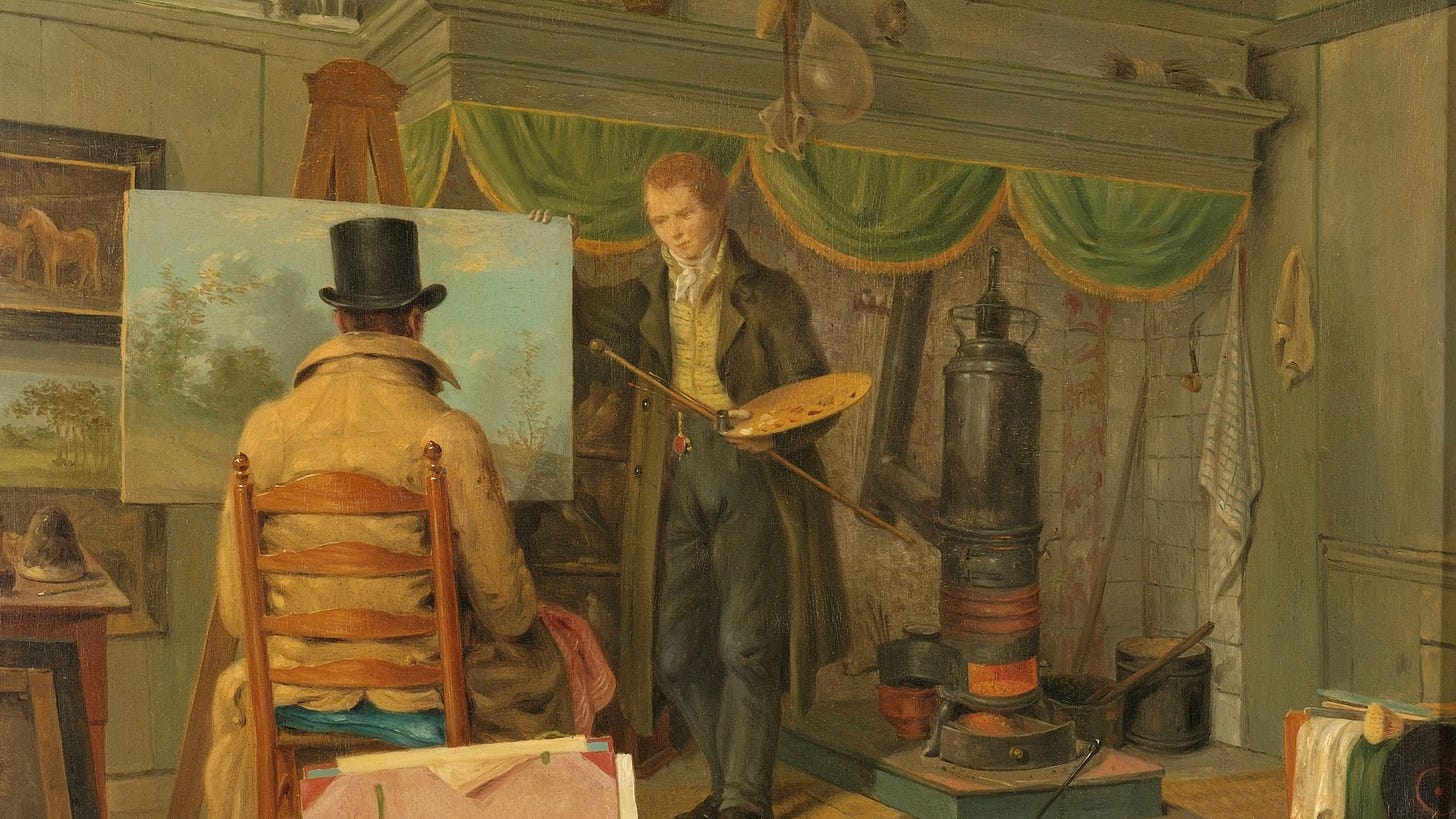Francis Ford Coppola's Non-Meme-able Anti-Content
"Megalopolis" is Bad Art. But At Least It's Art.
Francis Ford Coppola’s Megalopolis has inspired much reflection about creativity, commerce, the freedom of the artist and the state of Hollywood. Today, novelist and WoC contributor Țara Isabella Burton adds her perspective to that conversation.
— Santiago Ramos, Executive Editor
Last week, I spoke at an event at Barnes & Noble with Agustina Bazterrica, an Argentinian writer whose “splatterpunk” novels and short stories are characterized by the granular precision of their descriptions of gore. I asked Bazterrica whether she saw herself as working within a particular tradition of transgressive violence — Burroughs, say, or Mirabeau — and how she hoped the reader would respond to her novels’ most violent scenes.
Her response struck me. She didn’t think about the reader at all, she said. Her writing was, rather, a process of self-exorcism: of finding stories, and words, with which to give voice to the “obsessions” that haunted her.
I’ve been thinking about that conversation all week. It’s been years since I’ve approached my own fiction as the untangling of obsessions. Sometimes I miss it.
It’s not that I don’t love my work. Part of the reason that my writing is less personal, less self-disclosing, than it once was, is because I love novels — writing them, reading them, imagining them. I think about technique and craft and what it means to engage with the expectations of genre. Generally speaking, I think it is a good thing for any artist to think of their work as something more than merely personal — a book or a poem or a painting or a piece of music that is intelligible because it exists in and through a shared human vocabulary. There is a difference between a novel — even a deeply personal novel — and a diary entry; between singing in the shower and singing on stage.
But there is another, less noble, side to the shift in my approach to novel-writing. The same self-conscious, self-overhearing authorial voice in my head, which tries to dialogue with Dostoevsky and Tolstoy, also argues with imagined reviewers, posters on Goodreads and editors. I hear scary voices telling me that The World Cannot Give is best advertised under the label of “dark-academia,” or that Here in Avalon should be shelved alongside other “literary fairy tales.”
It’s inevitable, of course. The algorithmic matchmaking of “cultural product” to “cultural consumer” prompts writers to think in terms of branding and marketing. Being conscious of readers, even when it is necessary, means also being conscious of buyers, of reviewers, of “fans.”
Which is why I’m so drawn to Megalopolis.
Francis Ford Coppola’s $120 million Robert Moses-meets-Rome epic is a failure, as far as movies go. I’m not even sure it’s a noble failure. The plot makes no sense; the love scenes are bloodless; characters shift their storytelling signifiers from scene to scene. (Is Mayor Cicero concerned with social welfare at the expense of utopian greatness — or does he just want to build casinos)? Much of the central story seems like a thinly veiled allegory for Coppola’s self-conceit: An implausibly rich, implausibly brilliant young architect with time-stopping powers and access to a mysterious and possibly organic building substance that may come from outer space, has a thoroughly anti-democratic dream for remaking the city of New Rome into his personal utopia, and despite mass opposition is ultimately vindicated in said dream by everyone around him.
I was warned of all this, going in. But, somehow, Megalopolis managed to be one of the only films I’ve been excited to see in theaters in a long time. Two hours and eighteen minutes later, I was glad I went.
By now you’ve probably seen the memes. Adam Driver (staggeringly sincere) as Cesar Catalina (mercurial genius scion of the Crassus family, with a political function that is never entirely clear), telling the mayor’s wayward (yet secretly brilliant and thoughtful) daughter Giula (Nathalie Emmanuel, flailing) to “go back to the club.”
I had worried, seeing clips of that scene online, that Megalopolis — already anticipating its cult-flop status — would be full of scenes like these: self-consciously courting a reception as an ironic phenomenon: a high-budget equivalent of notorious indie disaster The Room. Come see the onetime titan of New Hollywood, the director of The Godfather, Apocalypse Now and The Conversation, collapse into irrelevant old age! Come see the flop, forty years in the making, that Coppola sold his vineyards to finance! You'll even get a scene where Jon Voight, as Crassus, disguises a crossbow as an enormous erection in order to murder his faithless wife, Wow Platinum [sic]!
I’ve seen this kind of marketing far too often: cultural franchises from Wandavision to Barbie to Wednesday treating the film or television show being marketed as, at best, convenient inspiration for the “real” cultural production: the next day’s Tumblr memes and Twitter discourses.
But, to my surprise, vexation, and, ultimately, delight, Megalopolis is not, in fact, a self-consciously campy picture. If it is camp, it’s camp in the sense elucidated by Susan Sontag, who described camp as a “seriousness that fails.” Whatever artistic sins Coppola is guilty of — and in Megalopolis he’s guilty of plenty — he is innocent of the worst, most craven kind of self-overhearing. Megalopolis was not made “for the fans,” or for the critics, or for Letterboxd reviewers. It was made for Francis Ford Coppola.
Megalopolis is, for better and for worse, the $120 million exorcism of a private obsession. It is epic both as a piece of filmmaking and as an effort at self-justification: an abrupt side-plot deals with Catalina’s mentally-ill-or-maybe-just-narcissistic mother (played by Coppola’s real-life sister Talia Shire), who verbally abuses her son, only to appear among Catalina’s admirers in the final scene). Driver’s Cesar Catalina is entitled, rude, self-aggrandizing — his first appearance consists of him performing Hamlet’s “To be or not to be” soliloquy; elsewhere he unironically refers to his “Emersonian mind” — and yet, by the film’s end, he has succeeded in capturing the hearts of imaginations of the entirety of New Rome. His utopia — unlike all the others — actually works.
Watching Megalopolis is, more than any other film I’ve seen recently, a hauntingly intimate experience. We the audience are experiencing, without irony or self-consciousness or market-siloed alienation, another human being’s untrammeled artistic vision. Of this, there is never a doubt, whether we’re watching Giancarlo Esposito’s Caesar recite Cicero’s first oration against Cataline at a wedding-gone-wrong, or Wow Platinum receive cunnilingus from her constitutionally ineffectual stepson Clodio Pulcher (Shia Laboeuf, like Driver perfectly cast for a role that demands an impossible lack of self-consciousness).
And yet we are not reading Francis Ford Coppola’s diary. We are not listening to him singing in the shower. Coppola actively, insistently, yearns to share his obsession with us. He wants us to love Cesar Catalina, and New Rome, and the quixotic dream of an unsullied empire, as much as he does. And he is talented enough to get us at least part of the way there. Megalopolis’ most successful sections — and even a few of its unsuccessful ones — come across as the passionate discourse of a bright teenage boy attempting to convince us that his special interest should be ours, too. (A telling biographical fact from Megalopolis’ press kit: Coppola spent a portion of his teenage years paralyzed from polio, escaping boredom by reading about the decline and fall of the Roman Empire.)
And, yes, Megalopolis is self-indulgent: a self-indulgence so overweening that it obliterates nearly all of Megalopolis’ artistic potential as a movie. It is, patently, bad art. But, in its badness, it is also reassuringly not “content.” It does not exist, as content does, merely as a two hour-long occasion for commerce or for discourse, for money or for memes. Content doesn’t care if you actually watch it, so long as you like, subscribe, and have a take. Megalopolis’ badness does not come from mediocrity, or from the inept courting of a particular self-serving emotional or political response on the part of the audience, or from being sufficiently problematic or not-problematic-enough to fuel a flotilla of think-pieces.
In this, Megalopolis is the anti-Barbie. Barbie is a decent film that suffers, most of all, from the fact that Barbie-the-film is nothing but a ticket to Barbie-the-phenomenon: an interconnected series of Ryan Gosling memes and monologues about the impossibility of modern feminism. Megalopolis, on the other hand, is messier; it is worse-written; its plot holes are more obvious. But it’s also far more compellingly human.
Art is a wager on meaning. We spend hours or years brushing colored egg yolk onto wood, or whittling stone into something we recognize as shapes, or slaving over sounds that other people recognize as ideas — practices slow and methodical and sometimes unpleasant — to produce something that has no obvious biological usefulness. It will not help us live longer, or find a mate or make healthy babies. The uselessness of art is what makes it a kind of prayer. We wager that what we do is worth doing.
But there is another, similar version of this wager. Whenever we attempt to disclose ourselves — in art, in song, or even just in the story we tell a stranger at a bar — we try not just to make sense of ourselves, but to justify ourselves: to prove that our lives have been lived, if not perfectly, then at least well; that the mistakes we have made have in some sense been counterweighted by redemptive success or at least by lessons learned; that we have not lived our lives in vain.
To experience a failed work of art is to experience something quintessentially human. To watch Megalopolis is to experience, for two hours and eighteen minutes, another human being’s account of himself, suffused with the terror that his life might have been lived in vain. It’s a worthwhile encounter. We are watching someone try to do something that matters, and he only partially fails. And we are looking at proof that trying is worth it.
Megalopolis may lend itself to a whole host of memes. But if we are drawn to Megalopolis, “back to the club” fan edits and all, it is not because Megalopolis’ marketing team wants us to shitpost until the movie becomes an inadvertent viral success. I think we’re drawn to it because, in the age of the attention economy, Coppola’s sincerity of vision, his unfathomable lack of irony, compels us. It reminds us that there’s something to our obsessions after all. Obsessions can make bad art. But they can never make content.
See also:
Wisdom of Crowds is a platform challenging premises and understanding first principles on politics and culture. Join us!







Constraint and community are such interestingly ambiguous influences on the artistic merit of a work. Sometimes the restrictions of a medium, or an industry, are exactly what give rise to creative brilliance. Sometimes it’s precisely the attempt to reach a specific audience that allows insight to emerge.
If the best that the film industry can produce, right now, is self-indulgent lack of restriction, then this is damning indeed. It suggests that the restrictions and community involvement that are available have managed to become so bankrupt that the creative tension between auteur and industry has lost its generative power entirely.
A good editor will restrict a writer; a good producer will restrict a director. If editors and producers lose their fidelity to anything other than the market, books and films will suffer for it, and creative freedom won’t fix it.
“In this, Megalopolis is the anti-Barbie.” Just perfect